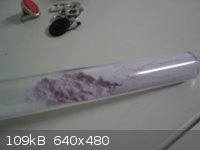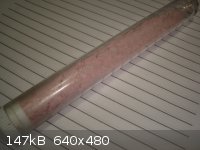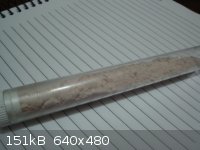| Pages:
1
..
6
7
8
9
10
..
24 |
Wizzard
Hazard to Others
  
Posts: 337
Registered: 22-3-2010
Member Is Offline
Mood: No Mood
|
|
@Blogfast- Certainly! During evaporation, trying to recover the last bit of Nd sulfate from solution, what I've found is left after evaporation is a
hard, brown/green/white amorphic mass at the bottom of the vessel, with or without unevaporated liquid solution.
I found this solution is nearly always VERY acidic- I would also imagine the solution it precipitated from is as well. When rehydrated, the mixture
makes a sparkley liquid, and the mass is difficult to get into solution, it takes much stirring and heat. The sparkley stuff (white/yellow, very fine)
is unknown, but I have isolated it (it comes off in the steam during any evaporation phase, and collects and crystallizes white, in solution it
develops a yellow tinge, likely due to iron oxide on contact with the water). The material then still will not crystallize and separate Nd from Fe
sulfate, it will only dry out and reform the same very hard mass.
Adding water to the mass, heavy stirring, some heat and a minimal of extra magnet material (I will not add something else to the mixture to only
neutralize the acid) results in a solution which looks much more like the original solution. Of course, now filter and clean the soltion of junk and
insoluables.
This solution will now act mostly normal- It will cool (from 80*C to 0*C) and crystallize large iron sulfate crystals, and upon removal of those (or
leave them in, it doesn't matter), when heated to 90*C and allowed to evaporate, will result in crystals of Nd sulfate. The material which
crystallizes is much greater than the mass of magnet material added to neutralize the acid- This hints that the problem (I think) is something about
the pH of the solution.
|
|
|
blogfast25
International Hazard
    
Posts: 10562
Registered: 3-2-2008
Location: Neverland
Member Is Offline
Mood: No Mood
|
|
Wizzkid:
Yes, I’ve seen your ‘sparkley stuff’ too, when working with quite concentrated iron solutions. It’s a bit like metallic paint, right? These
must be hydroxy ferric compounds, possibly Fe(OH)SO4 or similar. By that time your ferrous sulphate will have been oxidised mostly to Fe (III) because
of heat and air exposure.
In my case sometimes I got the stuff to dissolve again, sometimes not. The sparkly effect must be due to shiny, platelet-like crystals, acting like
mirrors, like in a flaky aluminium powder-resin mixture (metallic paint).
[Edited on 10-2-2012 by blogfast25]
|
|
|
Poppy
Hazard to Others
  
Posts: 294
Registered: 3-11-2011
Member Is Offline
Mood: † chemical zombie
|
|
You guys mean there should be kept about a half ammount of the hydroxides to replace them to the final solution thus neutralizing it?
What about just throwing ammonia in there? anyone ever tried this? Will the Nd still behave the same manner when heated, i.e., precipitating?
Has anyone tried this? I'll if none did.
|
|
|
Wizzard
Hazard to Others
  
Posts: 337
Registered: 22-3-2010
Member Is Offline
Mood: No Mood
|
|
@Blogfast- Yes, like paint  I have a small vial of the material, perhaps I should
test it's composition... But I would not know where to start. I have a small vial of the material, perhaps I should
test it's composition... But I would not know where to start.
|
|
|
blogfast25
International Hazard
    
Posts: 10562
Registered: 3-2-2008
Location: Neverland
Member Is Offline
Mood: No Mood
|
|
Wizzard:
You'd have to isolate the 'shiny' material first and I bet it filters very badly.
Poppy:
Ammonia is great for gradually adjusting pH. Not sure what you mean by the rest.
|
|
|
Wizzard
Hazard to Others
  
Posts: 337
Registered: 22-3-2010
Member Is Offline
Mood: No Mood
|
|
@Blogfast- It doesn't need to be filtered, it can be isolated in the evaporation condensate on the sides and top of the vessel, free from water. I'm
very sure it's 100@ 'shiny'  Picture in a bit. Picture in a bit.
|
|
|
Poppy
Hazard to Others
  
Posts: 294
Registered: 3-11-2011
Member Is Offline
Mood: † chemical zombie
|
|
Blogfast: I mean if Nd-ammonium double salts would precipitate the same way neodimmy sulfate does.
Nvm, ammonia has just been added into the solution, bringing the pH from 1.3 to 1.8-1.9 with a pH meter. Ionic strenghts seems to be playing a role
there so the calculations useing this information are kinda complicated for me.
For all of you guys, is it just me but neodymium compounds has like a somewhat sweet smell? That be a wonder of nature, of course!!
The solution was set to evaporate at room temp and the salts remained the same color.
|
|
|
Wizzard
Hazard to Others
  
Posts: 337
Registered: 22-3-2010
Member Is Offline
Mood: No Mood
|
|
New crystal pictures- Evaporative growth over 2 weeks (in 2 stages to remove iron) lead to these crystals from the smaller, 'scrap' Nd2(204)3 stock I
have prepared.
The largest single crystal at the bottom, double-terminated (but flat on one side) is 1.8cm in length!
All large crystals of this Nd sulfate show the same fracturing seen in previous large crystals- I do not know what causes this, but the previous
largest crystal (I would guess 2.2cm!!) broke on removal from the growing glass.
And I can get some pics of the Nd iodide soon, also- I'll be making another batch! The oxide is also a by-product, which is just as pretty.

|
|
|
blogfast25
International Hazard
    
Posts: 10562
Registered: 3-2-2008
Location: Neverland
Member Is Offline
Mood: No Mood
|
|
Very nice crystals, as per usual.
How did you synth. the NdI3?
|
|
|
Poppy
Hazard to Others
  
Posts: 294
Registered: 3-11-2011
Member Is Offline
Mood: † chemical zombie
|
|
the ammoniacal Nd solution I`ve spoken about is as yet unchanged. I'll keep this until finding the proper evaporatio carryin devic
es Crystal trips via boiling coprecipitates Fe2O3 (or maybe we talking about lanthanide impurities?) mainly in the secondary preci
pitation steps. ~ Very nice thx or the images
|
|
|
Wizzard
Hazard to Others
  
Posts: 337
Registered: 22-3-2010
Member Is Offline
Mood: No Mood
|
|
Poppy, can you describe your ammon. Nd solution? I'm building a beautiful color-changing display for my RE salts 
|
|
|
Poppy
Hazard to Others
  
Posts: 294
Registered: 3-11-2011
Member Is Offline
Mood: † chemical zombie
|
|
Wizz,
The ammoniacal solution was made this way:
1 mol Neodimmy hydroxide was mixed with 2 mol conc. sulfuric acid. The solution was afterward neutralised with 1 mol ammonia which brought pH to 4 -
5. The thick syrup did evaporate a little bit and the crystals formed changes from lavander through pink depending on lighting. It followed that the
once precipitated ironIII hydroxides redissolved as the concentration raised in the solution, leaving a brownish supernatant liquid over the
crystals.
=P
the ammonia helps the crystal growing fat
Oh sorry to the other chemicals water was added to makeup 530mL, with the initially poured 20g Nd(OH)3
[Edited on 3-5-2012 by Poppy]
[Edited on 3-5-2012 by Poppy]
|
|
|
Poppy
Hazard to Others
  
Posts: 294
Registered: 3-11-2011
Member Is Offline
Mood: † chemical zombie
|
|
Considering the mass of the supposedly double salt thus obtained I can't tell if ammonia entered the crystal at any degree. If the mass surpasses the
expected ratio then ammonia definitely played its role. The very pure Nd salt seems relatively more soluble now though.
|
|
|
Poppy
Hazard to Others
  
Posts: 294
Registered: 3-11-2011
Member Is Offline
Mood: † chemical zombie
|
|
Photos of 99.9999%-iron free Nd sulfate. The ammoniacal salts remained in the crystalization liquor.
Neodimium sulfate under large fluorescent tubes:
[img]http://www.sciencemadness.org/talk/files.php?pid=240121&aid=17879[/img]
" under small fluorescent tubes:
[img]http://www.sciencemadness.org/talk/files.php?pid=240121&aid=17882[/img]
"under tungsten lamp lighting:
[img]http://www.sciencemadness.org/talk/files.php?pid=240121&aid=17884[/img]
  
[Edited on 3-8-2012 by Poppy]
[Edited on 3-8-2012 by Poppy]
|
|
|
blogfast25
International Hazard
    
Posts: 10562
Registered: 3-2-2008
Location: Neverland
Member Is Offline
Mood: No Mood
|
|
Quote: Originally posted by Poppy  | Photos of 99.9999%-iron free Nd sulfate. The ammoniacal salts remained in the crystalization liquor.
|
Poppy, can you explain again (briefly) where the ammonia comes into things?
Also, how can you substantiate your '99.9999 %' claim? On what grounds?
|
|
|
Poppy
Hazard to Others
  
Posts: 294
Registered: 3-11-2011
Member Is Offline
Mood: † chemical zombie
|
|
Blogfast,
Ammonia comes into nothing, apparenttly, it was used to neutralise a fraction of the excess sulfuric acid
The purity is a relative 99.9999% iron free (which means no iron at all), not 99.9999% pure Nd sulfate. The acidic washing bath with sulfuric acid
should have reached this, or maybe its just wrong?
I reallty guess it was too straight an assumption, but considering that by througly sinkings the products allowed for a high quality trustworthy final
product.
99.9999% was simply too much way out the strathosphere.
|
|
|
blogfast25
International Hazard
    
Posts: 10562
Registered: 3-2-2008
Location: Neverland
Member Is Offline
Mood: No Mood
|
|
Poppy:
Ah. Test your product with KSCN or NH4SCN by leaching some of it with cold water, add a bit of H2O2 to the leachate (to oxidise any to Fe (III)). Fe3+
tests positive for red FeSCN2+ if any iron present. It's a fairly sensitive test.
Your product looks very neat though...
[Edited on 8-3-2012 by blogfast25]
|
|
|
Poppy
Hazard to Others
  
Posts: 294
Registered: 3-11-2011
Member Is Offline
Mood: † chemical zombie
|
|
I'm gonna bring this to my university, they got KSCN there, buying this is not likely affordable in normal circunstances.
|
|
|
elementcollector1
International Hazard
    
Posts: 2684
Registered: 28-12-2011
Location: The Known Universe
Member Is Offline
Mood: Molten
|
|
I've been reading through this thread, and I'm confused as to the oxalate route. I recently acquired some "Davy's Oxalic Acid Crystals" which I assume
are pure, and added this to a gray (not purple, for some reason) solution of 'magnet chloride'. I now have a green supernatant liquid, and a
greenish-gray precipitate. What did I do wrong, and how can I fix this?
Elements Collected:52/87
Latest Acquired: Cl
Next in Line: Nd
|
|
|
blogfast25
International Hazard
    
Posts: 10562
Registered: 3-2-2008
Location: Neverland
Member Is Offline
Mood: No Mood
|
|
EC1:
As I’m not sure as to your exact procedure it’s a little difficult to comment. I’ll just say this.
Your ‘magnet chloride’ should be emerald green, of FeCl2.
The method relies on the fact that Nd oxalate is very insoluble but of iron exists a ferric trisoxalato complex -
FeOx<sub>3</sub><sup>3-</sup> - bright green, slightly fluorescent and very soluble. To convert all iron to the complex,
firstly the Fe (II) needs to be oxidised with H2O2 to Fe (III). Do this by adding the required amount of ice cold peroxide to iced magnet chloride,
slowly!
At that point, iron (III) (hydr)oxide probably started precipitating (or it may not, depending on pH of the solution). Now add a calculated excess of
oxalic acid [note: you need to account for the neodymium oxalate too!], dissolved in warm water, slowly while slowly heating the solution until the
brown Fe(OH)3 dissolved to green FeOx<sub>3</sub><sup>3-</sup> (this can take a while to be fully achieved). The off-white
precipitate formed is Nd<sub>2</sub>Ox<sub>3</sub>. Hot filter to avoid excess oxalic acid to crystallise out and confuse you.
Wash Nd oxalate copiously…
Careful: oxalic acid is toxic! Wear suitable gloves and goggles at all times!
All in all the straight 'sulphuric acid method' is probably simpler but the one time I tried it, I couldn't get the magnet to dissolve easily because
the dissolution 'stalled' and I had to resort to HCl to complete it... Others haven't had that problem.
[Edited on 13-3-2012 by blogfast25]
[Edited on 13-3-2012 by blogfast25]
|
|
|
elementcollector1
International Hazard
    
Posts: 2684
Registered: 28-12-2011
Location: The Known Universe
Member Is Offline
Mood: Molten
|
|
Just filtered my solution, and you're right, it is emerald green. Why were my previous solutions purple?
Anyway, from what I'm inferring from your post, upon slow addition of chilled peroxide to chilled magnet chloride, the iron hydroxide should start
precipitating out. What happens to its chloride ions? Then, add mucho oxalic acid in (what is warm, 50 degrees? near boiling?) until no more
precipitate forms, and do this while heating the other mix (this will be tricky on the home stove, and even trickier on the camp burner). Correct?
Elements Collected:52/87
Latest Acquired: Cl
Next in Line: Nd
|
|
|
blogfast25
International Hazard
    
Posts: 10562
Registered: 3-2-2008
Location: Neverland
Member Is Offline
Mood: No Mood
|
|
Due to suspended particulate matter, unfiltered solutions may appear very different from filtered ones. Don't worry about it.
Add the warm (50 to 100 C is OK) oxalic acid solution slowly while heating the oxidised magnet soup to simmering. After some time the red-brown
slurry-solution will clear to green (the precipitated Nd oxalate tends to accumulate at the bottom). Careful doing this on the stove: a dedicated
second hand domestic elecrtical hot plate is much to be preferred because of the potential for boil overs and the toxicity of OA!
The chloride ends up basically as dissolved HCl.
[Edited on 14-3-2012 by blogfast25]
|
|
|
elementcollector1
International Hazard
    
Posts: 2684
Registered: 28-12-2011
Location: The Known Universe
Member Is Offline
Mood: Molten
|
|
I'll see if I can find or borrow a hot plate.
So, the oxalate precipitate is purple? That's what I got online, anyway. My first precipitate, which I assume is a mix of neodymium and iron (II)
oxalates, was a grayish-green.
Elements Collected:52/87
Latest Acquired: Cl
Next in Line: Nd
|
|
|
blogfast25
International Hazard
    
Posts: 10562
Registered: 3-2-2008
Location: Neverland
Member Is Offline
Mood: No Mood
|
|
Neodymium oxalate is off-white, probably with a purple tinge, under incandescent light. But speaking of its colour is a bit meaningless: remember that
Nd salts look decidedly different under incandescent light or TL light (or saver bulbs) because traces of UV cause the salts to fluoresce greenish!
It's one simple way of recognising Nd salts...
Let us know how you get on.
[Edited on 14-3-2012 by blogfast25]
|
|
|
elementcollector1
International Hazard
    
Posts: 2684
Registered: 28-12-2011
Location: The Known Universe
Member Is Offline
Mood: Molten
|
|
I did the steps slightly out of order: I added the H2O2, and then chilled it in a freezer. An hour later, nothing had changed, no precipitate of
anything. The current color of the solution is yellow, different from the emerald green. Should I add more H2O2? I added a whole ton already.
Elements Collected:52/87
Latest Acquired: Cl
Next in Line: Nd
|
|
|
| Pages:
1
..
6
7
8
9
10
..
24 |